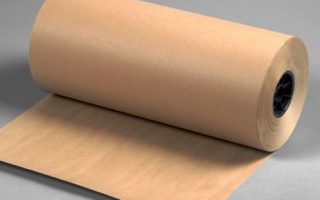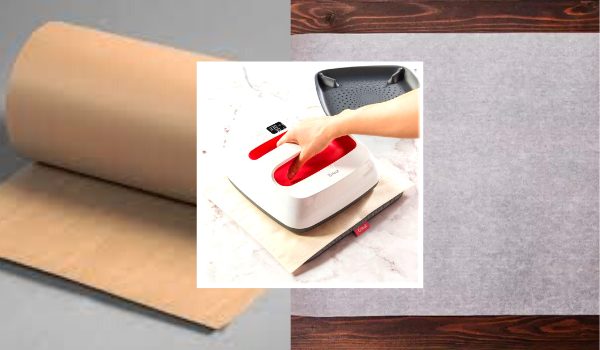Butcher Paper vs Parchment Paper For Heat Press
The main difference between the parchment paper and butcher paper is the material. Parchment paper is made of cotton, while butcher paper is made of a combination of cotton and wood pulp.
Butcher paper is thicker and tougher than parchment paper, which makes it more durable under pressure. Parchment paper tears more easily than butcher paper. Both can be used for heat press. However, parchment paper is best for iron-on vinyl.
What is butcher paper?
Butcher paper is a heavy-duty paper that is typically used by butchers or restaurants to wrap or cover the meat. It is also used as a surface to write on when drawing or painting, to protect the surface below.
Butcher paper is very popular among crafters because it’s typically large and has a smooth finish, so it’s easy to draw, paint, cut, and glue on.

There are 4 main types of butcher paper:
White butcher paper
White butcher paper is very versatile. You can use it to wrap snacks, sandwiches, and even arts and crafts without the worry of a paper product running out. Additionally, it can also be used as table coverings or to prevent various stains on tabletops.
White butcher paper is breathable so it can be used to wrap meat before smoking. The paper lets smoke in but prevents moisture loss and allows the meat to cook evenly.
Pink Butcher Paper
Pink butcher paper is used to hide any blood or juices from raw meats as it has a pink-colored tissue. The paper is strong enough to prevent leaks but doesn’t suffocate the package so that the meat stays fresh for longer.
Gardenia Butcher Paper
Gardenia Butcher Paper is an exceptional paper product that offers superior protection and moisture resistance. It is often preferred over plastic wrapping since it prevents leaks of oil or juices, but also leaves the product breathable enough for food to breathe.
Steak Butcher Paper
Displaying your meats in steak paper is a great way to showcase meats. The paper can seal in the juices and will not fade the color of your product.
What is parchment paper?
Parchment paper is a light brown type of baking paper that is used in baking and cooking to make the clean-up after baking easier. It is made of a thin, but strong paper that resists moisture.
It is popular among crafters because it is non-stick and it can be used for anything from baking to making crafts. The crafter’s classroom has plenty of uses for this versatile paper.

There are two main types of parchment paper:
Bleached parchment paper
The parchment paper that has been treated with chlorine is known as bleached parchment paper. This paper has been treated with a silicone coating, making it resistant to dampness and heat as well as nonstick.
Unbleached parchment paper
This baking paper is not chlorine treated and it contains fewer chemicals than the bleached one. It’s considered healthier than the bleached one. That being said, it is also treated with silicone to make it heat as well as moisture resistant.
Alternative to parchment paper for heat transfer vinyl
You can use aluminum foil as an alternative to parchment paper. However, you need to be extremely careful as it is very thin.
Best parchment paper for heat press
- No more measuring and cutting
- Eco-friendly material
- Resist temperatures up to 420 Degree F
- Easy clean
FAQs
Can you use butcher paper with a heat press?
Yes, butcher paper can be used with a heat press. While it is not the best material to use with a heat press, it will work.
Can you use parchment paper with a heat press?
You can use parchment paper for a heated press transfer of dark color fabrics. Place the parchment paper on top of the dark color transfer paper and in between the Teflon sheet – this will allow for smooth surface results.
Parchment paper is heat resistant and can be reused as long as it has been cleaned and there are no signs of discoloration.
Can you use parchment paper for heat transfer vinyl?
Yes, you can use parchment paper for HTV. Parchment paper is an affordable substitute for transfer paper that produces quality prints. It’s coated with a wax layer which allows the image to transfer without difficulty.
Can parchment paper be used instead of butcher paper for sublimation?
Parchment paper is perfect to work with when you’re crafting in HTV. It gives the item a protective layer from damage and maintains moisture on the fabric. However, it is not recommended for sublimation printing because moisture can seep through the material.
What can I use if I don’t have butcher paper?
You can use aluminum foil, wax paper, parchment paper, or kitchen towels if you don’t have butcher paper.
What kind of butcher paper is best for sublimation?
White butcher paper is best for sublimation because it is heavy-duty and breathable.
Can you use butcher paper for iron-on vinyl?
Yes, you can use butcher paper for iron-on vinyl. Butcher paper is coated with wax to make it non-stick, so it is a good idea to use it for iron-on vinyl.
Is Teflon sheet the same as parchment paper?
No, Teflon sheet and parchment paper are not the same, but parchment paper can be used as a substitute for Teflon sheet when heat pressing.
Both Teflon sheets and parchment paper are heat-resistant, but Teflon sheets are specifically designed for heat pressing, while parchment paper is traditionally used for baking. However, parchment paper is easier to find in local grocery stores and can withstand temperatures above 400 degrees, making it a good alternative for Teflon sheets.
Can you use wax paper for heat transfer vinyl?
No, you should not use wax paper for heat transfer vinyl. Wax paper is not heat-resistant and the wax coating can melt at high temperatures, which can ruin the vinyl transfer and damage your project.
It Is best to use parchment paper instead, which is heat-resistant and safe to use for heat transfer vinyl.
Do you need parchment paper for cricut easy press?
Yes, you need parchment paper, an Iron-On Protective sheet, or Teflon sheet when using the Cricut EasyPress. This sheet acts as protection, prevents the vinyl from sticking to the iron, prevents overheating, and helps prevent carrier sheet marks on the vinyl.

I’ve been in the printing business for 25 years. I love to share my experiences and knowledge.


